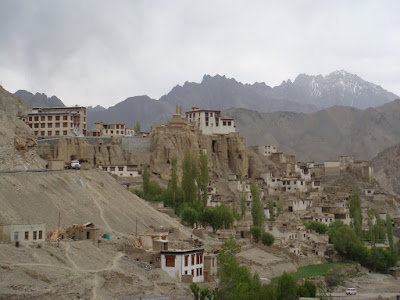It was in the queue before the SBI ATM in Leh that I met Fee, a tourist from Germany. She was standing in front of me. She was travelling alone too. She had just arrived in Leh and did not have a definite plan. I was looking for someone to share my taxi with, so I could visit some more places around. Within a few minutes, a plan was made. We went to a travel agency which by the way happened to be close to Fee’s hotel.
The monasteries west of Leh interested me. I had a few places in my list within 60 kilometers of Leh, but the agent agreed to give us a discount and I included Lamayuru as well, a place that was 125 kilometers from Leh, the pictures of which looked unusually different and out of this world.
And what more, Fee had met with two others who had planned to go to Pangong lake that had been a preoccupation with me ever since I saw pictures of it, ever since I heard of its peacock blue waters from those that had just returned from the place.
They were three and just one more could be accommodated. And it was destined to be ME.
Everything fell into place so perfectly. I consider myself lucky in these matters. Or perhaps, I want it so badly, so earnestly, that the universe conspires to make it happen.
We planned to leave at 8 in the morning so we could cover as many places s possible. I looked forward to this with delight.
We started a little later than 8.


This route for some distance was grand and solemn, but as we went further west, it turned into a charming one.
As we started there were the rugged mountains, eternal, with enormous spaces separating them, the serpentine roads seeming over-ambitious as they scaled these mountains.
After some distance, there was the unexpected appearance of charming green fields sprinkled generously with yellow flowers right by the road; just a small patch of emerald set neatly in a surrounding of gold; disappearing as suddenly as it had appeared.

As we drove, there were some more such fields. Each one was a surprise and we stopped at every one of them.
After some more driving, the Sindhu river emerged. Grander than I had seen her before, marching on in the valley.

As we approached Lamayuru, the landscape changed. It was unlike anything I had seen before. This place is called the moon valley since it has lunar landscapes.
During the full moon tourists pitch their tent here and I believe the sight is spectacular.
This looks like a huge field of sand. Some children scooped out portions with a shovel/spoon disproportionate to the size of the sand basin, creating the impressions of engravings of a common pattern.
The monastery. What a spectacular setting.
Lamayuru village and its fields lie below the monastery. The cliff on which the monastery stands, a promontory like spur, is heavily eroded, its sides jagged and bare. The village homes, chortens, monks’ quarters, blend seamlessly almost as though they aren’t manmade but part of the natural landscapes.

Avalokiteshwara
There is a mythical story that Lamayuru corrie(a circular hollow in the side of a hill or mountain) was once a great lake and this may well be true; the moonland depression closeby, geologists believe, was certainly one. A great Arhat used his spiritual powers to open a crack at the side of the basin and drain the lake. Prophesysing that a monastery would come up above the depression, he planted corn on its edges that ripened in the shape of swastikas. Lamayuru is called Yang-Drung Gompa, that being the Tibetan word for swastika.











































5 comments:
Sowmya,
You mentioned about Sindhu river. This reminded me of the book again "Empires of the Indus". Author Alice Albinia, an English lady also travelled all these places and what she mentioned about Sindhu is what you see is just the waters from the tributries and the actually Sindhu source has been blocked in Tibet by a Dam by China.
Rishi.
Sowmya,
Also in the book its mentioned that Polyandry is quite common in that region Leh/Ladakh. Did you see that.
Rishi.
I have started reading Empires of the Indus. Just two days ago.
Depressing to know that we just see the tributeries and not the actual river though i dont completely believe it. Some water I am sure trickles through the dam to the valley...
I am going to Ladakh this July with parents again.. hence reading the book to understand some background.
My June end trip to Ladakh stands canceled. I don't like your blog so much anymore you know :|
Notgogol,
Make it happen. Somehow....
Post a Comment